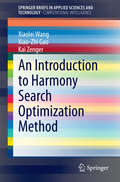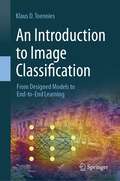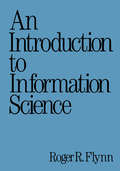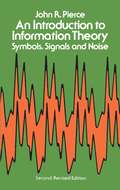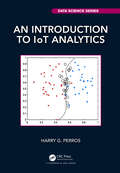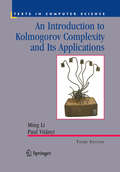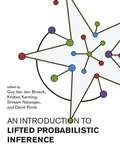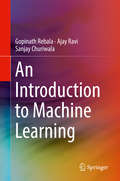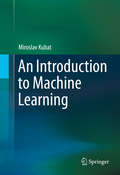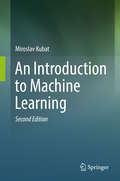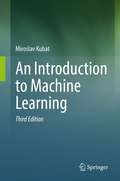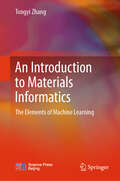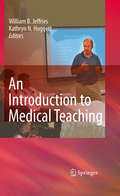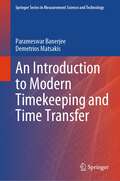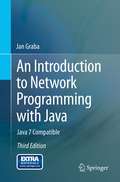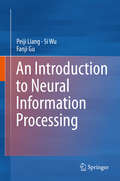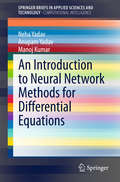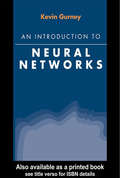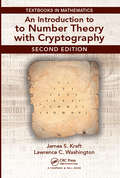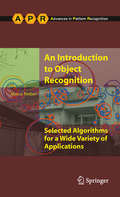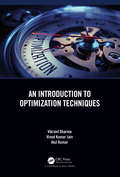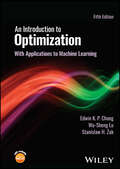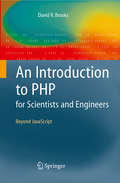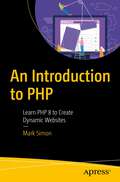- Table View
- List View
An Introduction to Harmony Search Optimization Method (SpringerBriefs in Applied Sciences and Technology)
by Xiaolei Wang Xiao-Zhi Gao Kai ZengerThis brief provides a detailed introduction, discussion and bibliographic review of the nature1-inspired optimization algorithm called Harmony Search. It uses a large number of simulation results to demonstrate the advantages of Harmony Search and its variants and also their drawbacks. The authors show how weaknesses can be amended by hybridization with other optimization methods. The Harmony Search Method with Applications will be of value to researchers in computational intelligence in demonstrating the state of the art of research on an algorithm of current interest. It also helps researchers and practitioners of electrical and computer engineering more generally in acquainting themselves with this method of vector-based optimization.
An Introduction to Image Classification: From Designed Models to End-to-End Learning
by Klaus D. ToenniesImage classification is a critical component in computer vision tasks and has numerous applications. Traditional methods for image classification involve feature extraction and classification in feature space. Current state-of-the-art methods utilize end-to-end learning with deep neural networks, where feature extraction and classification are integrated into the model. Understanding traditional image classification is important because many of its design concepts directly correspond to components of a neural network. This knowledge can help demystify the behavior of these networks, which may seem opaque at first sight. The book starts from introducing methods for model-driven feature extraction and classification, including basic computer vision techniques for extracting high-level semantics from images. A brief overview of probabilistic classification with generative and discriminative classifiers is then provided. Next, neural networks are presented as a means to learn a classification model directly from labeled sample images, with individual components of the network discussed. The relationships between network components and those of a traditional designed model are explored, and different concepts for regularizing model training are explained. Finally, various methods for analyzing what a network has learned are covered in the closing section of the book. The topic of image classification is presented as a thoroughly curated sequence of steps that gradually increase understanding of the working of a fully trainable classifier. Practical exercises in Python/Keras/Tensorflow have been designed to allow for experimental exploration of these concepts. In each chapter, suitable functions from Python modules are briefly introduced to provide students with the necessary tools to conduct these experiments.
An Introduction to Information Science
by Roger FlynnThis book comprises an introduction to information as an external commodity; a data base that can be manipulated, retrieved, transmitted, and used. It is useful at an introductory undergraduate level and also for anyone who is new to the field of Information Science.
An Introduction to Information Security and ISO27001
by Steve G WatkinsThis book furnishes readers with an understanding of the basics of information security, including: a definition of what information security means; how managing information security can be achieved using an approach recognized world-wide; the sorts of factors that need to be considered in an information security regime, including how the perimeters of such a scheme can be properly defined; how an information security management system can ensure it is maximizing the effect of any budget it has; what sort of things resources might be invested in to deliver a consistent level of assurance; and how organizations can demonstrate the degree of assurance they offer with regards to information security, how to interpret claims of adherence to the ISO 27001 standard and exactly what it means. Corporate bodies will find this book useful at a number of stages in any information security project, including at the decision-making stage, at project initiation stage, and as part of an on-going awareness campaign.
An Introduction to Information Theory: Symbols, Signals and Noise
by John R. PierceBehind the familiar surfaces of the telephone, radio, and television lies a sophisticated and intriguing body of knowledge known as information theory. This is the theory that has permeated the rapid development of all sorts of communication, from color television to the clear transmission of photographs from the vicinity of Jupiter. Even more revolutionary progress is expected in the future.To give a solid introduction to this burgeoning field, J. R. Pierce has revised his well-received 1961 study of information theory for an up-to-date second edition. Beginning with the origins of the field, Dr. Pierce follows the brilliant formulations of Claude Shannon and describes such aspects of the subject as encoding and binary digits, entropy. language and meaning, efficient encoding , and the noisy channel. He then goes beyond the strict confines of the topic to explore the ways in which information theory relates to physics, cybernetics, psychology, and art. Mathematical formulas are introduced at the appropriate points for the benefit of serious students. A glossary of terms and an appendix on mathematical notation are provided to help the less mathematically sophisticated.J. R. Pierce worked for many years at the Bell Telephone Laboratories, where he became Director of Research in Communications Principles. He is currently affiliated with the engineering department of the California Institute of Technology. While his background is impeccable, Dr. Pierce also possesses an engaging writing style that makes his book all the more welcome. An Introduction to Information Theory continues to be the most impressive non-technical account available and a fascinating introduction to the subject for laymen."An uncommonly good study. . . . Pierce's volume presents the most satisfying discussion to be found."- Scientific American.
An Introduction to IoT Analytics (Chapman & Hall/CRC Data Science Series)
by Harry G. PerrosThis book covers techniques that can be used to analyze data from IoT sensors and addresses questions regarding the performance of an IoT system. It strikes a balance between practice and theory so one can learn how to apply these tools in practice with a good understanding of their inner workings. This is an introductory book for readers who have no familiarity with these techniques. The techniques presented in An Introduction to IoT Analytics come from the areas of machine learning, statistics, and operations research. Machine learning techniques are described that can be used to analyze IoT data generated from sensors for clustering, classification, and regression. The statistical techniques described can be used to carry out regression and forecasting of IoT sensor data and dimensionality reduction of data sets. Operations research is concerned with the performance of an IoT system by constructing a model of the system under study and then carrying out a what-if analysis. The book also describes simulation techniques. Key Features IoT analytics is not just machine learning but also involves other tools, such as forecasting and simulation techniques. Many diagrams and examples are given throughout the book to fully explain the material presented. Each chapter concludes with a project designed to help readers better understand the techniques described. The material in this book has been class tested over several semesters. Practice exercises are included with solutions provided online at www.routledge.com/9780367686314 Harry G. Perros is a Professor of Computer Science at North Carolina State University, an Alumni Distinguished Graduate Professor, and an IEEE Fellow. He has published extensively in the area of performance modeling of computer and communication systems.
An Introduction to Kolmogorov Complexity and Its Applications (Texts in Computer Science)
by Ming Li Paul M. B. Vitányi"The book is outstanding and admirable in many respects. ... is necessary reading for all kinds of readers from undergraduate students to top authorities in the field." Journal of Symbolic Logic Written by two experts in the field, this is the only comprehensive and unified treatment of the central ideas and applications of Kolmogorov complexity. The book presents a thorough treatment of the subject with a wide range of illustrative applications. Such applications include the randomness of finite objects or infinite sequences, Martin-Loef tests for randomness, information theory, computational learning theory, the complexity of algorithms, and the thermodynamics of computing. It will be ideal for advanced undergraduate students, graduate students, and researchers in computer science, mathematics, cognitive sciences, philosophy, artificial intelligence, statistics, and physics. The book is self-contained in that it contains the basic requirements from mathematics and computer science. Included are also numerous problem sets, comments, source references, and hints to solutions of problems. New topics in this edition include Omega numbers, Kolmogorov-Loveland randomness, universal learning, communication complexity, Kolmogorov's random graphs, time-limited universal distribution, Shannon information and others.
An Introduction to Lifted Probabilistic Inference (Neural Information Processing series)
by David PooleRecent advances in the area of lifted inference, which exploits the structure inherent in relational probabilistic models.Statistical relational AI (StaRAI) studies the integration of reasoning under uncertainty with reasoning about individuals and relations. The representations used are often called relational probabilistic models. Lifted inference is about how to exploit the structure inherent in relational probabilistic models, either in the way they are expressed or by extracting structure from observations. This book covers recent significant advances in the area of lifted inference, providing a unifying introduction to this very active field. After providing necessary background on probabilistic graphical models, relational probabilistic models, and learning inside these models, the book turns to lifted inference, first covering exact inference and then approximate inference. In addition, the book considers the theory of liftability and acting in relational domains, which allows the connection of learning and reasoning in relational domains.
An Introduction to Machine Learning
by Sanjay Churiwala Gopinath Rebala Ajay RaviJust like electricity, Machine Learning will revolutionize our life in many ways – some of which are not even conceivable today. This book provides a thorough conceptual understanding of Machine Learning techniques and algorithms. Many of the mathematical concepts are explained in an intuitive manner. The book starts with an overview of machine learning and the underlying Mathematical and Statistical concepts before moving onto machine learning topics. It gradually builds up the depth, covering many of the present day machine learning algorithms, ending in Deep Learning and Reinforcement Learning algorithms. The book also covers some of the popular Machine Learning applications. The material in this book is agnostic to any specific programming language or hardware so that readers can try these concepts on whichever platforms they are already familiar with. Offers a comprehensive introduction to Machine Learning, while not assuming any prior knowledge of the topic;Provides a complete overview of available techniques and algorithms in conceptual terms, covering various application domains of machine learning;Not tied to any specific software language or hardware implementation.
An Introduction to Machine Learning
by Miroslav KubatThis book presents basic ideas of machine learning in a way that is easy to understand, by providing hands-on practical advice, using simple examples, and motivating students with discussions of interesting applications. The main topics include Bayesian classifiers, nearest-neighbor classifiers, linear and polynomial classifiers, decision trees, neural networks, and support vector machines. Later chapters show how to combine these simple tools by way of "boosting," how to exploit them in more complicated domains, and how to deal with diverse advanced practical issues. One chapter is dedicated to the popular genetic algorithms.
An Introduction to Machine Learning
by Miroslav KubatThis book presents basic ideas of machine learning in a way that is easy to understand, by providing hands-on practical advice, using simple examples, and motivating students with discussions of interesting applications. The main topics include Bayesian classifiers, nearest-neighbor classifiers, linear and polynomial classifiers, decision trees, neural networks, and support vector machines. Later chapters show how to combine these simple tools by way of "boosting," how to exploit them in more complicated domains, and how to deal with diverse advanced practical issues. One chapter is dedicated to the popular genetic algorithms.
An Introduction to Machine Learning
by Miroslav KubatThis textbook offers a comprehensive introduction to Machine Learning techniques and algorithms. This Third Edition covers newer approaches that have become highly topical, including deep learning, and auto-encoding, introductory information about temporal learning and hidden Markov models, and a much more detailed treatment of reinforcement learning. The book is written in an easy-to-understand manner with many examples and pictures, and with a lot of practical advice and discussions of simple applications. The main topics include Bayesian classifiers, nearest-neighbor classifiers, linear and polynomial classifiers, decision trees, rule-induction programs, artificial neural networks, support vector machines, boosting algorithms, unsupervised learning (including Kohonen networks and auto-encoding), deep learning, reinforcement learning, temporal learning (including long short-term memory), hidden Markov models, and the genetic algorithm. Special attention is devoted to performance evaluation, statistical assessment, and to many practical issues ranging from feature selection and feature construction to bias, context, multi-label domains, and the problem of imbalanced classes.
An Introduction to Materials Informatics: The Elements of Machine Learning
by Tongyi ZhangThis textbook educates current and future materials workers, engineers, and researchers on Materials Informatics. Volume I serves as an introduction, merging AI, ML, materials science, and engineering. It covers essential topics and algorithms in 11 chapters, including Linear Regression, Neural Networks, and more. Suitable for diverse fields like materials science, physics, and chemistry, it enables quick and easy learning of Materials Informatics for readers without prior AI and ML knowledge.
An Introduction to Medical Teaching
by William B. Jeffries Kathryn HuggettFew faculty members in academic medical centres are formally prepared for their roles as teachers. This work is an introductory text designed to provide medical teachers with the core concepts of effective teaching practice and information about innovations for curriculum design, delivery, and assessment. It offers brief, focused chapters with content that is easily assimilated by the reader. Topics are relevant to basic science and clinical teachers, and the work does not presume readers possess prerequisite knowledge of education theory or instructional design. The authors emphasize application of concepts to teaching practice. Topics include: Helping Students Learn; Teaching Large Groups; Teaching in Small Groups; Problem Based Learning; Team-Based Learning, Teaching Clinical Skills; Teaching with Simulation; Teaching with Practicals and Labs; Teaching with Technological Tools; Designing a Course; Assessing Student Performance; Documenting the Trajectory of your Teaching and Teaching as Scholarship. Chapters were written by leaders in medical education and research who draw upon extensive professional experience and the literature on best practices in education. Although designed for teachers, the work reflects a learner-centred perspective and emphasizes outcomes for student learning. The book is accessible and visually interesting, and the work contains information that is current, but not time-sensitive. The work includes recommendations for additional reading and an appendix with resources for medical education.
An Introduction to Modern Timekeeping and Time Transfer (Springer Series in Measurement Science and Technology)
by Parameswar Banerjee Demetrios MatsakisThis book provides a comprehensive, systematic description of modern timekeeping and its specializations. Introductory chapters discuss the concept of time and its definition, then briefly look at pre-Atomic Era timekeeping to set the stage for the introduction of the atomic clock. Subsequent chapters focus on concepts such as frequency stability and measurement uncertainty, as well as computer network time-synchronization protocols including Network Time Protocol (NTP) and Precise Time Protocol (PTP). The book then delves into the nuts and bolts of the Global Navigation Satellite Systems (GNSS), Two-Way Satellite Time and Frequency Transfer, and Optical Time and Frequency Transfer. Timescale theory is then described as a way to combine clock data, and the algorithms and procedures used to generate Coordinated Universal Time (UTC) are given. Finally, there is a look at modern applications of timekeeping and time transfer.Featuring a glossary of all key terms, this book is highly recommended for trained or incoming physicists, engineers, or mathematicians working, for example, in manufacturing or timing laboratories. Additionally, it is suitable for use in introductory university courses dealing with the subject of timekeeping.
An Introduction to Network Programming with Java: Java 7 Compatible
by Jan GrabaSince the second edition of this text, the use of the Internet and networks generally has continued to expand at a phenomenal rate. This has led to both an increase in demand for network software and to improvements in the technology used to run such networks, with the latter naturally leading to changes in the former. During this time, the Java libraries have been updated to keep up with the new developments in network technology, so that the Java programming language continues to be one of the mainstays of network software development. In providing a very readable text that avoids getting immersed in low-level technical details, while still providing a useful, practical guide to network programming for both undergraduates and busy IT professionals, this third edition continues the trend of its predecessors. To retain its currency, the text has been updated to reflect changes that have taken place in Java's network technology over the past seven years (including the release of Java 7), whilst retaining its notable features of numerous code examples, screenshots and end-of-chapter exercises.
An Introduction to Neural Information Processing
by Fanji Gu Peiji Liang Si WuThis book provides an overview of neural information processing research, which is one of the most important branches of neuroscience today. Neural information processing is an interdisciplinary subject, and the merging interaction between neuroscience and mathematics, physics, as well as information science plays a key role in the development of this field. This book begins with the anatomy of the central nervous system, followed by an introduction to various information processing models at different levels. The authors all have extensive experience in mathematics, physics and biomedical engineering, and have worked in this multidisciplinary area for a number of years. They present classical examples of how the pioneers in this field used theoretical analysis, mathematical modeling and computer simulation to solve neurobiological problems, and share their experiences and lessons learned. The book is intended for researchers and students with a mathematics, physics or informatics background who are interested in brain research and keen to understand the necessary neurobiology and how they can use their specialties to address neurobiological problems. It is also provides inspiration for neuroscience students who are interested in learning how to use mathematics, physics or informatics approaches to solve problems in their field.
An Introduction to Neural Network Methods for Differential Equations (SpringerBriefs in Applied Sciences and Technology)
by Manoj Kumar Neha Yadav Anupam YadavThis book introduces a variety of neural network methods for solving differential equations arising in science and engineering. The emphasis is placed on a deep understanding of the neural network techniques, which has been presented in a mostly heuristic and intuitive manner. This approach will enable the reader to understand the working, efficiency and shortcomings of each neural network technique for solving differential equations. The objective of this book is to provide the reader with a sound understanding of the foundations of neural networks and a comprehensive introduction to neural network methods for solving differential equations together with recent developments in the techniques and their applications. The book comprises four major sections. Section I consists of a brief overview of differential equations and the relevant physical problems arising in science and engineering. Section II illustrates the history of neural networks starting from their beginnings in the 1940s through to the renewed interest of the 1980s. A general introduction to neural networks and learning technologies is presented in Section III. This section also includes the description of the multilayer perceptron and its learning methods. In Section IV, the different neural network methods for solving differential equations are introduced, including discussion of the most recent developments in the field. Advanced students and researchers in mathematics, computer science and various disciplines in science and engineering will find this book a valuable reference source.
An Introduction to Neural Networks
by Kevin GurneyThough mathematical ideas underpin the study of neural networks, the author presents the fundamentals without the full mathematical apparatus. All aspects of the field are tackled, including artificial neurons as models of their real counterparts; the geometry of network action in pattern space; gradient descent methods, including back-propagation; associative memory and Hopfield nets; and self-organization and feature maps. The traditionally difficult topic of adaptive resonance theory is clarified within a hierarchical description of its operation. The book also includes several real-world examples to provide a concrete focus. This should enhance its appeal to those involved in the design, construction and management of networks in commercial environments and who wish to improve their understanding of network simulator packages. As a comprehensive and highly accessible introduction to one of the most important topics in cognitive and computer science, this volume should interest a wide range of readers, both students and professionals, in cognitive science, psychology, computer science and electrical engineering.
An Introduction to Number Theory with Cryptography (Textbooks in Mathematics)
by James Kraft Lawrence Washington<p>Building on the success of the first edition, An Introduction to Number Theory with Cryptography, Second Edition, increases coverage of the popular and important topic of cryptography, integrating it with traditional topics in number theory. <p>The authors have written the text in an engaging style to reflect number theory's increasing popularity. The book is designed to be used by sophomore, junior, and senior undergraduates, but it is also accessible to advanced high school students and is appropriate for independent study. It includes a few more advanced topics for students who wish to explore beyond the traditional curriculum.</p>
An Introduction to Object Recognition: Selected Algorithms for a Wide Variety of Applications (Advances in Computer Vision and Pattern Recognition)
by Marco Alexander TreiberRapid development of computer hardware has enabled usage of automatic object recognition in an increasing number of applications, ranging from industrial image processing to medical applications, as well as tasks triggered by the widespread use of the internet. Each area of application has its specific requirements, and consequently these cannot all be tackled appropriately by a single, general-purpose algorithm. This easy-to-read text/reference provides a comprehensive introduction to the field of object recognition (OR). The book presents an overview of the diverse applications for OR and highlights important algorithm classes, presenting representative example algorithms for each class. The presentation of each algorithm describes the basic algorithm flow in detail, complete with graphical illustrations. Pseudocode implementations are also included for many of the methods, and definitions are supplied for terms which may be unfamiliar to the novice reader. Supporting a clear and intuitive tutorial style, the usage of mathematics is kept to a minimum. Topics and features: presents example algorithms covering global approaches, transformation-search-based methods, geometrical model driven methods, 3D object recognition schemes, flexible contour fitting algorithms, and descriptor-based methods; explores each method in its entirety, rather than focusing on individual steps in isolation, with a detailed description of the flow of each algorithm, including graphical illustrations; explains the important concepts at length in a simple-to-understand style, with a minimum usage of mathematics; discusses a broad spectrum of applications, including some examples from commercial products; contains appendices discussing topics related to OR and widely used in the algorithms, (but not at the core of the methods described in the chapters). Practitioners of industrial image processing will find this simple introduction and overview to OR a valuable reference, as will graduate students in computer vision courses. Marco Treiber is a software developer at Siemens Electronics Assembly Systems, Munich, Germany, where he is Technical Lead in Image Processing for the Vision System of SiPlace placement machines, used in SMT assembly.
An Introduction to Optimization Techniques
by Atul Kumar Vinod Kumar Jain Vikrant SharmaAn Introduction to Optimization Techniques introduces the basic ideas and techniques of optimization. Optimization is a precise procedure using design constraints and criteria to enable the planner to find the optimal solution. Optimization techniques have been applied in numerous fields to deal with different practical problems. This book is designed to give the reader a sense of the challenge of analyzing a given situation and formulating a model for it while explaining the assumptions and inner structure of the methods discussed as fully as possible. It includes real-world examples and applications making the book accessible to a broader readership. Features Each chapter begins with the Learning Outcomes (LO) section, which highlights the critical points of that chapter. All learning outcomes, solved examples and questions are mapped to six Bloom Taxonomy levels (BT Level). Book offers fundamental concepts of optimization without becoming too complicated. A wide range of solved examples are presented in each section after the theoretical discussion to clarify the concept of that section. A separate chapter on the application of spreadsheets to solve different optimization techniques. At the end of each chapter, a summary reinforces key ideas and helps readers recall the concepts discussed. The wide and emerging uses of optimization techniques make it essential for students and professionals. Optimization techniques have been applied in numerous fields to deal with different practical problems. This book serves as a textbook for UG and PG students of science, engineering, and management programs. It will be equally useful for Professionals, Consultants, and Managers.
An Introduction to Optimization: With Applications to Machine Learning (Wiley Series In Discrete Mathematics And Optimization Ser. #77)
by Edwin K. Chong Wu-Sheng Lu Stanislaw H. ŻakAn Introduction to Optimization Accessible introductory textbook on optimization theory and methods, with an emphasis on engineering design, featuring MATLAB® exercises and worked examples Fully updated to reflect modern developments in the field, the Fifth Edition of An Introduction to Optimization fills the need for an accessible, yet rigorous, introduction to optimization theory and methods, featuring innovative coverage and a straightforward approach. The book begins with a review of basic definitions and notations while also providing the related fundamental background of linear algebra, geometry, and calculus. With this foundation, the authors explore the essential topics of unconstrained optimization problems, linear programming problems, and nonlinear constrained optimization. In addition, the book includes an introduction to artificial neural networks, convex optimization, multi-objective optimization, and applications of optimization in machine learning. Numerous diagrams and figures found throughout the book complement the written presentation of key concepts, and each chapter is followed by MATLAB® exercises and practice problems that reinforce the discussed theory and algorithms. The Fifth Edition features a new chapter on Lagrangian (nonlinear) duality, expanded coverage on matrix games, projected gradient algorithms, machine learning, and numerous new exercises at the end of each chapter. An Introduction to Optimization includes information on: The mathematical definitions, notations, and relations from linear algebra, geometry, and calculus used in optimization Optimization algorithms, covering one-dimensional search, randomized search, and gradient, Newton, conjugate direction, and quasi-Newton methods Linear programming methods, covering the simplex algorithm, interior point methods, and duality Nonlinear constrained optimization, covering theory and algorithms, convex optimization, and Lagrangian duality Applications of optimization in machine learning, including neural network training, classification, stochastic gradient descent, linear regression, logistic regression, support vector machines, and clustering. An Introduction to Optimization is an ideal textbook for a one- or two-semester senior undergraduate or beginning graduate course in optimization theory and methods. The text is also of value for researchers and professionals in mathematics, operations research, electrical engineering, economics, statistics, and business.
An Introduction to PHP for Scientists and Engineers: Beyond JavaScript
by David R. BrooksThis book provides an introduction to PHP and server-side programming. It presents readers with a science or engineering background with the information to write their own online applications requiring reading, creating and manipulating data files stored as text on a server, overcoming the limitations of a client-side language. It focuses only on those elements of the language, such as file input/output, arrays, built-in math functions, and user-created functions that are essential for solving a wide range of scientific/engineering computing problems - and assumes a working knowledge of programming concepts and HTML, JavaScript, C or a similar language. It contains complete applications and hence offers a very compact and efficient way for working professionals to take advantage of the possibilities offered by server-side programming. Written for a technical audience, this book is an effective learning tool to the essentials of PHP and is also ideal for self-study.
An Introduction to PHP: Learn PHP 8 to Create Dynamic Websites
by Mark SimonUse PHP to enhance your web pages. This book shows you how PHP programming works, and how to write and organize PHP code. The book starts with steps to download and install a setup for a sample website that will form the basis for upcoming chapters. You start by writing PHP code and learn how to mix it with HTML and manage the code. From there, you will learn about dynamic content, along with a deep dive into form processing and sending email. Saving uploaded data and uploading files is discussed next. You will learn how to configure your PHP project and develop a library. You will then learn how to create an image catalog and manage data on your web page. By the end of the book, you will understand how to work with cookies, sessions, and logging in, followed by an example of creating a simple blog that reiterates the concepts developed in the previous chapters.After reading this book, you will be able to configure, create, and manage your dynamic website.What Will You LearnKnow the basics of programming with the PHP languageUse PHP to generate dynamic web pagesWork with SQL databasesWork with forms to upload text data and binary filesUse tips and tricks to write clean and maintainable codeWho This Book Is ForWeb developers and students learning to develop and maintain PHP code on their website
